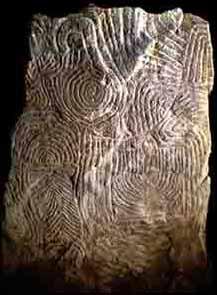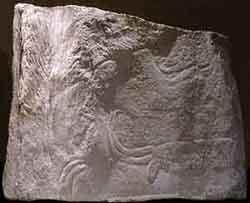- Home
- Megalithism in Morbihan
- Gavrinis
- Earlier decoration
Re-worked earlier decoration
Earlier motifs can be made out in several places. Two of them are particularly representative.
The "crosiers stele" in the chamber
This slab stands out because of the more sober markings it displays, compared to those on the nearby slabs. Two series of crosiers are superimposed and symmetrical vis a vis a vertical axis. The top of the stone was re-cut in the middle so that all the steles could be the same height, damaging the upper part of the decoration. However the outlines of rounded shoulders remain visible on either side.
A "stele" can therefore be reconstructed; it is very similar in type to the larger one that forms the chevet wall of the Table-des-Marchands in Locmariaquer; but here earlier decoration was not preserved.
Another stele in the passage
Several pre-existing lines seem to display fairly indistinguishable "gavrinian" style motifs:
- In the lower section, two quadrangular "shields" were subsequently covered either by chevrons or crescents;
- In the upper section, a large shield covers the whole width of the stone; it contains a splendid "crosier" with the staff disappearing in a spiral motif.
Once more, the top of the stone seems to have been mutilated.
Severely damaged "stele with crosiers", re-used as a pillar in the chamber.
Pillar 25 in the passage: probably a stele on which earlier decoration was preserved and completed at a later stage.
Hidden earlier decoration
In Gavrinis, several slabs have decorations which are only just visible, if at all, from inside the crypt, implying that the decoration dates from before the installation of the blocks.
As for re-worked decoration, it is usually similar in style to the art of the "classic" passage tombs.
Chevrons, axes and horn-shaped motifs
- The north-western "edge facing" (chamber side) of pillar 20 has a dual series of oblique lines (15 left, 18 right) pecked shallowly and precisely on both sides of a "virtual axis", on the naturally smooth fissure surface. The result is a series of boxed chevrons going down far below the slabbing level, in contrast to the decoration of the main face.
- The two edge facings of the chamber sill, i.e. twin fissure edges, also have a geometrical decoration, with a "grid" style on the chamber side, and a boxed chevron style on the entrance side (when the stone was boxed in the slabbing, this decoration was entirely hidden).
- When pillar 15 back at the far end of the chamber was exposed during excavation, a pair of classic handled axes framing what was probably a small very faded square shield became visible.
- The reverse side of Pillar 20 is decorated with an extensive motif that can be interpreted as the representation of a high axe blade, with the butt probably included in a prehension and ostension device (another almost identical axe is similar situated on the Pen-Hap dolmen, in L'Île-aux-Moines).
- The rounded edge facing of the second lintel covering the beginning of the passage reveals two high horn-shaped motifs, side-by-side but separated by a series of small boxed crescents. Nevertheless, the upward concavity shows that the patterns were designed for a stone already lying horizontal on the ground, as is still the case now.
The chamber roof
The upper face of the large orthogneiss slab was exposed during the latest excavations, and appeared to be entirely shaped.
- The lateral edge facings (NE and SW) correspond to fractures, obviously due to a series of notches forming a characteristically crenelated edge.
- A huge 2.8-metre-long "axe-plough", very similar in type to the one decorating the Grand Menhir in Locmariaquer, takes up all the northern part of the surface, the top of the dorsal "loop" being truncated by the NE fracture.
- The profile of an animal (certainly bovine) occupies the southern part. The body is squat and only just sketched in, but the head is more elaborate with quite meticulously drawn high curved horns on top.
- The SW fracture cuts through two other horns and a second animal's spine. A small "psi"-like motif and several cupmarks complete the decoration that could be connected with the motif on the roof of the Table-des-Marchands in Locmariaquer. This suggests a massive 14-metre-high decorated monolith probably erected in the alignment associated with the Grand Menhir.
Boxed chevrons on the edge facing of pillar 20.
Alternating chevrons on an edge facing of the chamber sill (on the passage side).
Upper side of the slab covering the chamber : two slightly crenelated fractures cut through the decoration (at the top and at the bottom of the photo).




